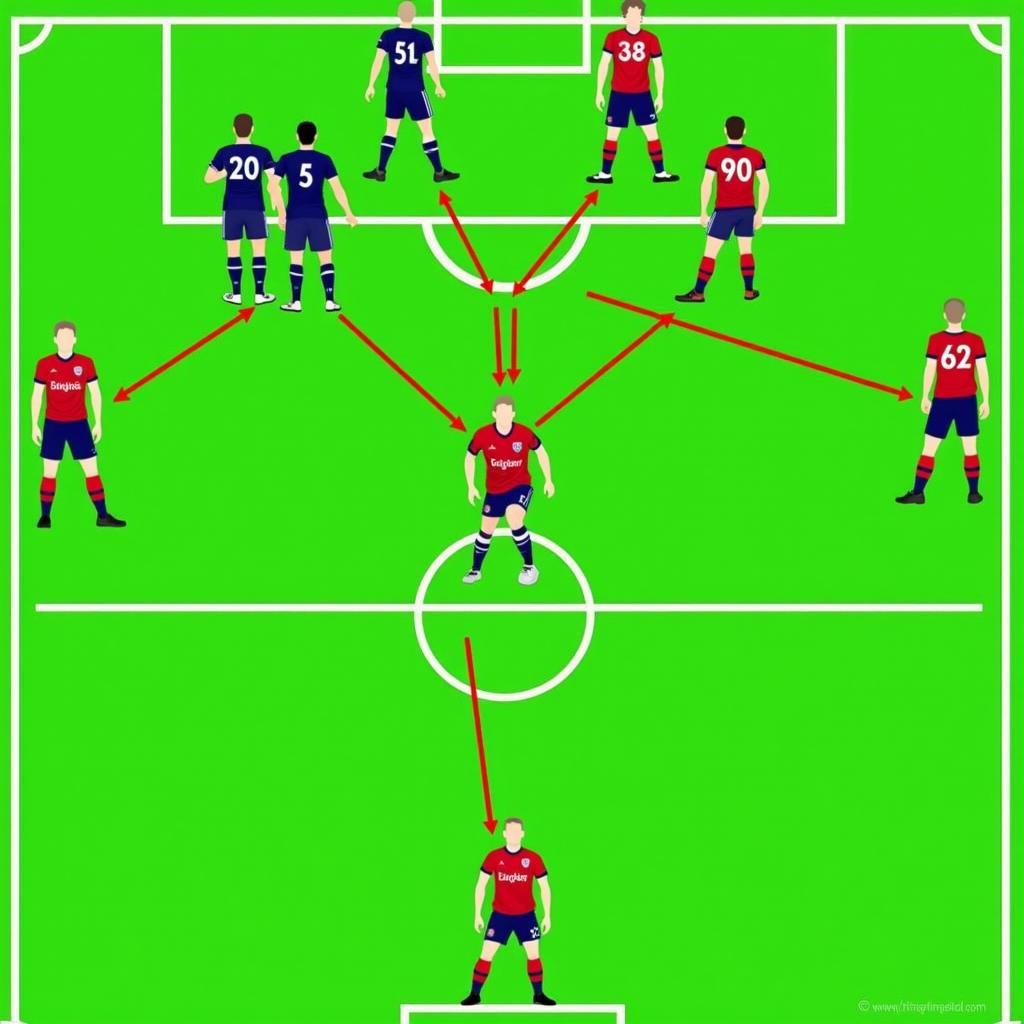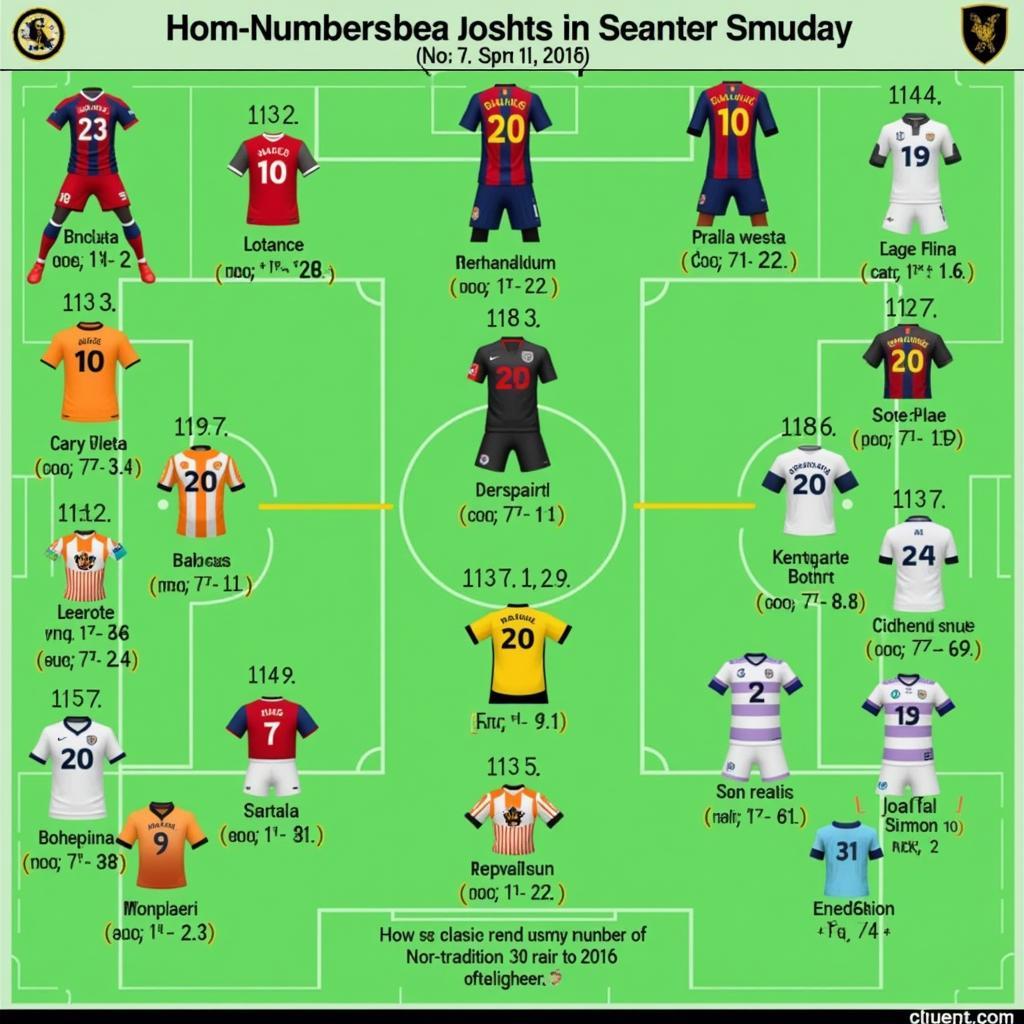Football Shirt Numbers: Decoding the Defender’s Code
December 31, 2024Football shirt numbers, especially those worn by defenders, have evolved from simple identifiers to symbolic representations of a player’s role and style. Understanding the significance of these football shirt numbers for defenders provides a deeper insight into the tactical nuances of the beautiful game. Let’s delve into the fascinating world of defender shirt numbers and uncover the stories they tell.  Defender Shirt Numbers and Tactics
Defender Shirt Numbers and Tactics
The Traditional Significance of Defender Shirt Numbers
Historically, football shirt numbers often followed a simple numerical order based on the team’s formation. Defenders typically wore numbers 2 through 6. The number 2 shirt was traditionally assigned to the right-back, while the number 3 was reserved for the left-back. The number 4 shirt usually denoted the center-back, and the number 5 was often worn by another central defender or a defensive midfielder. The number 6 could be worn by another central defender or a more versatile full-back. This traditional numbering system, while less rigid now, still holds some significance.
Evolution of Defender Shirt Numbers
However, modern football has seen a shift from these rigid assignments. Players now often choose numbers for personal reasons, such as birthdays, lucky numbers, or to honor past legends. For example, you might see a central defender wearing number 15 or a full-back sporting number 23. This personalization has added another layer of intrigue to the world of football shirt numbers.
 Modern Defender Shirt Numbers in Football
Modern Defender Shirt Numbers in Football
What does the number 4 signify for a defender? Traditionally, the number 4 shirt represents the heart of the defense, a player known for their strength, leadership, and tactical awareness.
What number do left-backs usually wear? Traditionally, the number 3 shirt is assigned to the left-back. However, as player preferences have become more influential, this isn’t always the case anymore. You might see left-backs wearing various numbers these days.
Are there any rules regarding defender shirt numbers? While there aren’t strict rules about which numbers defenders must wear, some numbers still carry a traditional association with certain defensive positions.
The Rise of Non-Traditional Defender Shirt Numbers
The move away from traditional shirt numbers doesn’t necessarily diminish their importance. They can still provide clues about a player’s role on the field. A defender wearing a higher number might suggest a more attacking approach, perhaps a full-back who frequently joins the attack. Conversely, a center-back wearing a lower number might indicate a more traditional, stay-at-home approach. This evolution of defender shirt numbers reflects the dynamic nature of modern football.
 Meaning of Non-Traditional Defender Shirt Numbers
Meaning of Non-Traditional Defender Shirt Numbers
Remember when I played for mod cầu thủ việt nam dream league soccer? The shirt numbers were crucial for identifying player positions quickly. It’s similar in real-life football.
Even in today’s game, you see links to tradition, like with some of the top giày có chữ ký cầu thủ which feature classic defender numbers. It’s fascinating how these traditions continue.
Defender Shirt Numbers: A Deeper Look
Beyond the simple numbers, there’s a deeper connection to player roles and team strategy. Understanding the nuances of each position’s traditional number can provide valuable insights into a team’s defensive setup.
Imagine a team where the central defenders wear 4 and 5, and the full-backs wear 2 and 3. This likely suggests a more conventional, four-at-the-back formation. However, if the defenders are wearing numbers like 15, 21, and 27, it might indicate a more fluid and dynamic defensive approach. This makes observing defender shirt numbers a fascinating aspect of tactical analysis. It’s similar to understanding the role of cầu thủ miranda, who was a versatile defender known for adapting to different systems.
This reminds me of my experiences playing with tất cả cầu thủ u23 việt nam, where understanding each player’s strengths and positions was crucial for success.
Conclusion
Football shirt numbers, particularly those worn by defenders, offer a fascinating glimpse into the history and evolution of the beautiful game. While the traditional significance of these numbers still holds some weight, the increasing personalization adds another dimension to their meaning. By understanding the nuances of defender shirt numbers, we can appreciate the tactical complexity and evolving nature of football. From the classic number 4 center-back to the modern, more fluid defensive roles, these numbers tell a story.
FAQ
-
What is the most common shirt number for a center-back? Traditionally, the number 4.
-
Can defenders wear any number they want? Yes, within the squad number limitations set by the league.
-
Do shirt numbers always reflect a player’s position? Not necessarily, as personal preference plays a large role.
-
Why are shirt numbers important in football? They help identify players and can also hint at their tactical role.
-
What is the significance of a defender wearing a high number? It can suggest a more attacking role, such as a full-back who overlaps frequently.
Do you have other questions about the role of a player who scored five goals like in cầu thủ ghi 5 bàn gọi là gì?
For any further assistance, feel free to contact us. Call us at 0396443476, email us at [email protected], or visit us at 23 Tháng 3, Đắk Nia, Gia Nghĩa, Đắk Nông, Việt Nam. We have a 24/7 customer service team ready to help.